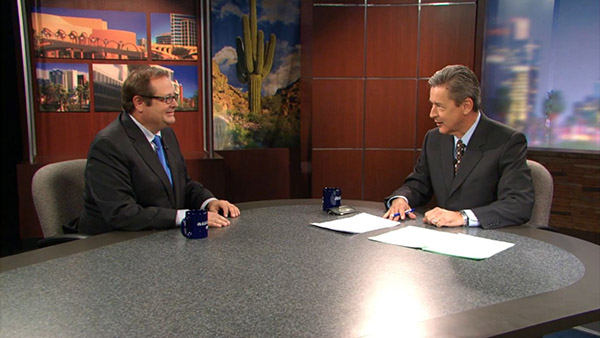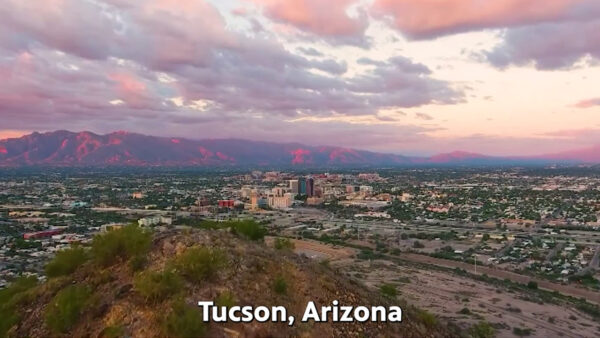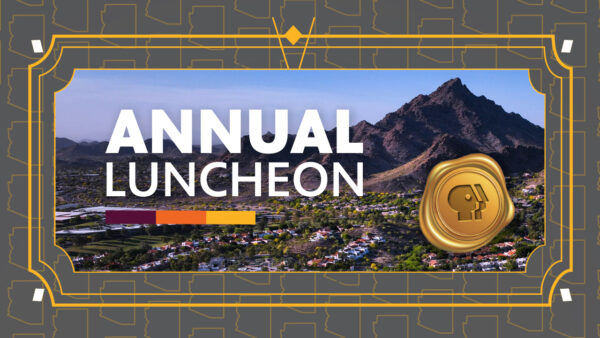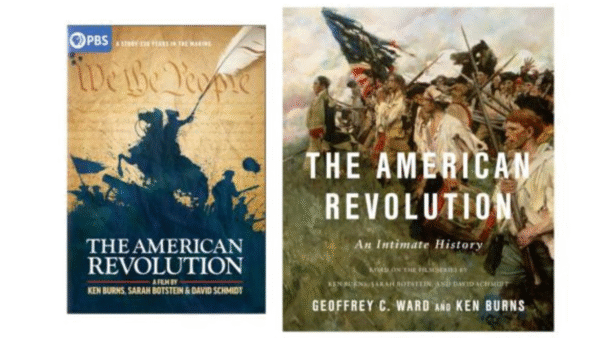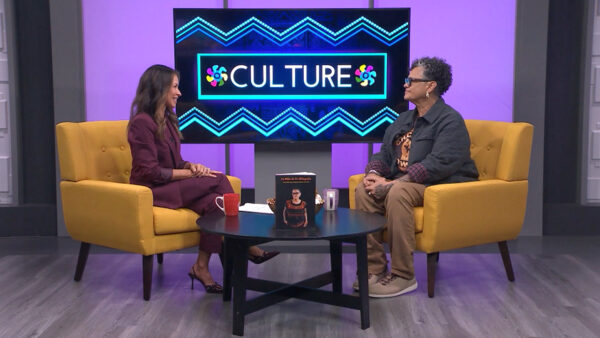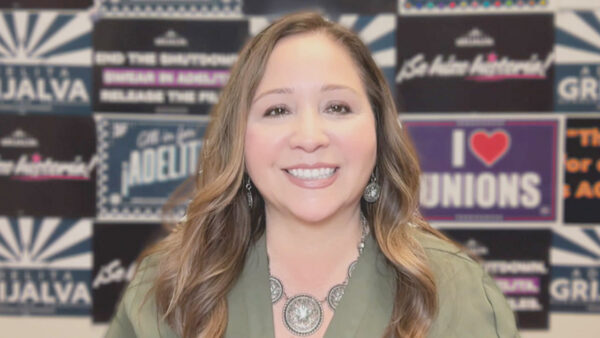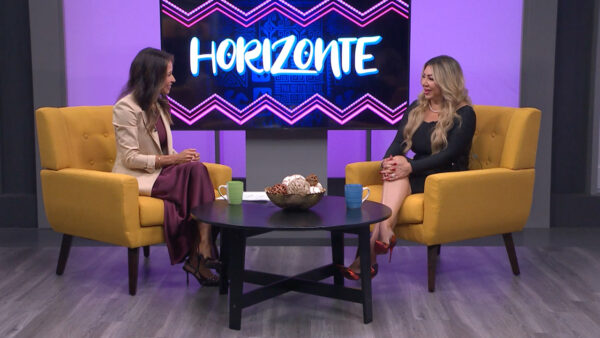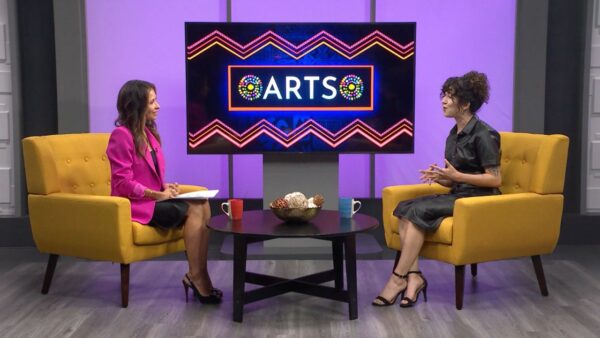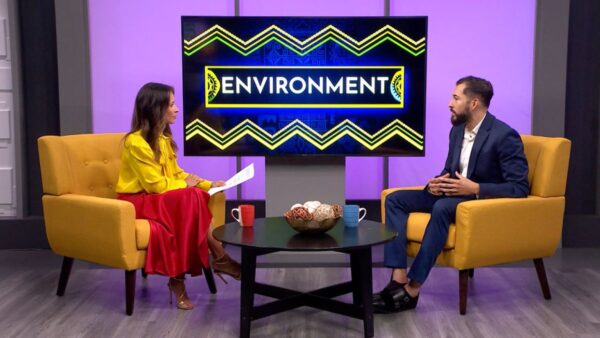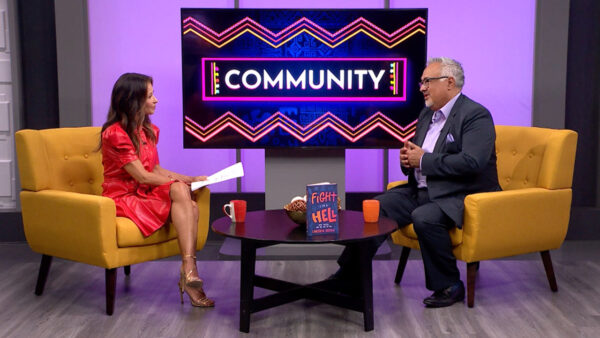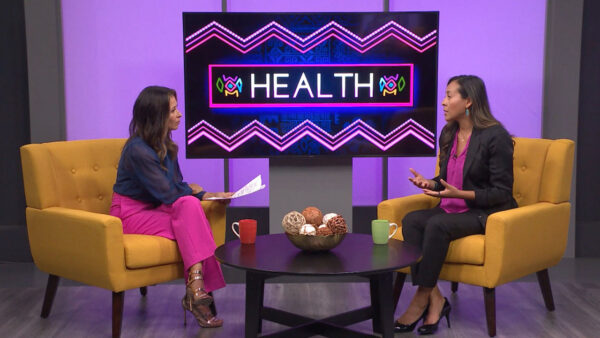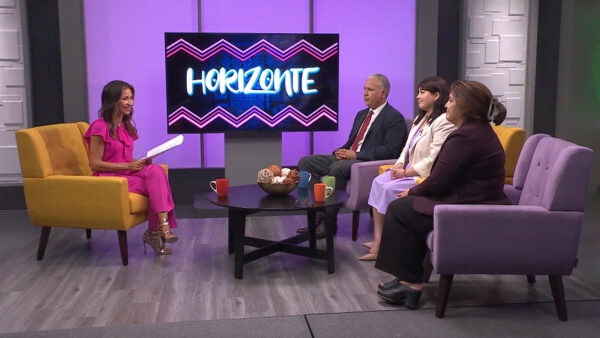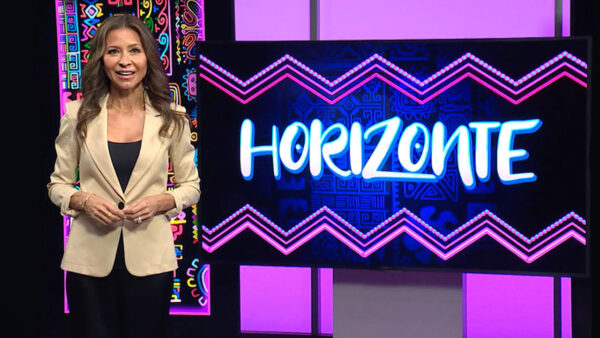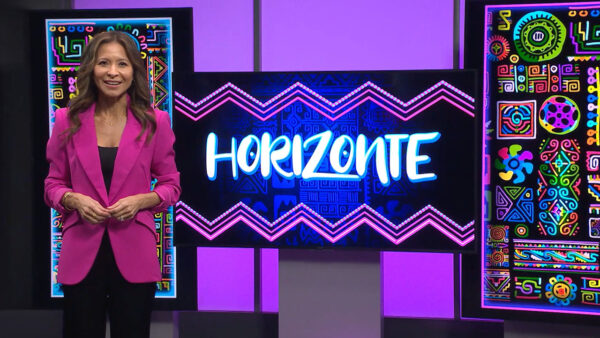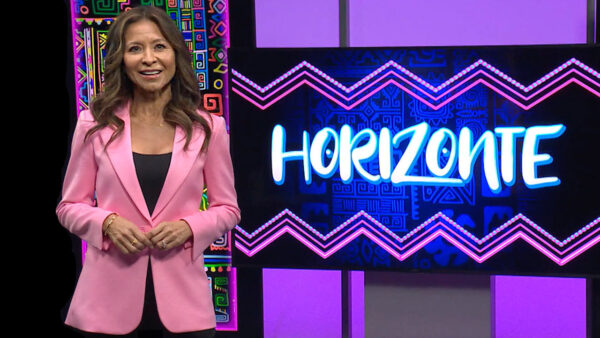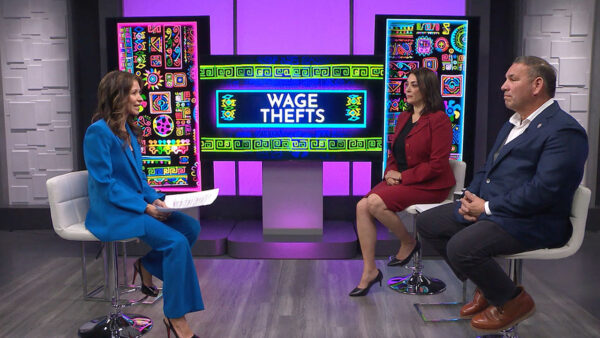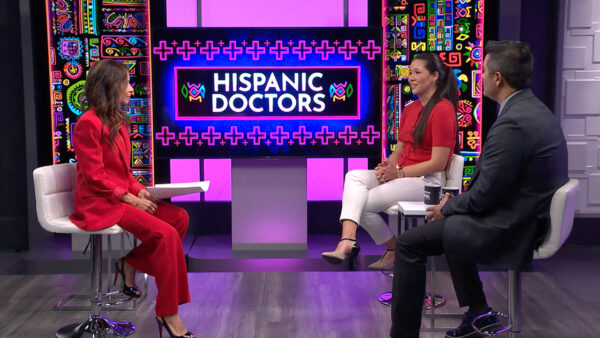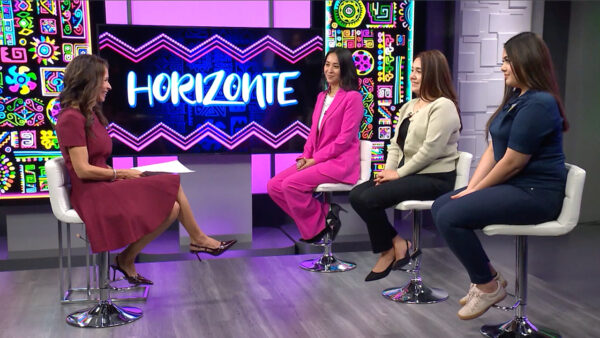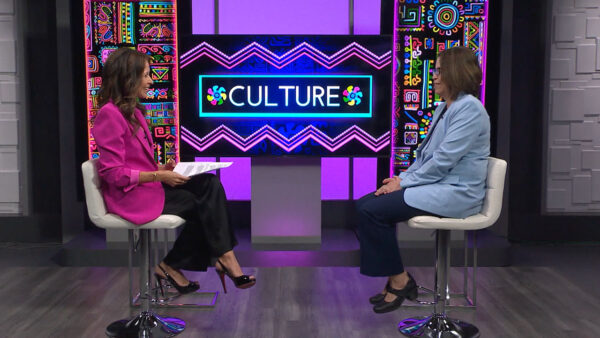October is Breast Cancer Awareness month. According to the American Cancer Society, breast cancer is the most commonly diagnosed cancer among Hispanic women. Patricia Elder, the Executive Director of The Susan G. Komen Breast Cancer Foundation of Phoenix, discusses breast cancer among Hispanics.
>> Jose Cardenas: Good evening, everyone. I'm Jose Cardenas. Welcome to "Horizonte." A plan to improve and develop the west side of Phoenix. We'll tell you what's being done for the area up next. Hispanics and breast cancer, How the disease affects women. And meet a woman bringing out the best in her community every day. All these stories coming up next on "Horizonte."
>> Reporter:
Funding for "Horizonte" is provided by Bank of America who applauds those who strive for excellence. And by SRP. SRP's business is water and power but our dedication to the community doesn't stop there. SRP, delivering more than power.
>> Jose Cardenas:
One of Phoenix's Fastest growing communities ss the city's west side. As new residents and businesses arrive, people are concerned the community won't have The resources and infrastructure to handle the new growth. In November 2004, the Phoenix City Council approved the West Phoenix Revitalization Strategy. $1 million was committed to find ways to improve the community. Phoenix's Neighborhood Services Department is taking several steps to bring improvements to the city's west side. With us tonight to talk about the strategy is Phoenix Neighborhood Services Department Program Manager Olivia Delgado-Carroll. Also here is the Department's Deputy Director, Tim Bolling. Tim, Olivia, welcome to "Horizonte." Olivia, tell us what area of town we're looking at, just the physical boundaries.
>> Olivia Delgado-Carroll:
The boundaries for the west side revitalization area are Van Buren to the south, Dunlap to the north, 19th Avenue to the east and the 101 to the west.
>> Jose Cardenas:
Is a big chunk of this what's commonly referred to as the Maryvale area?
>> Olivia Delgado-Carroll: Yes, it is, but it also encompasses other neighborhoods. It encompasses also the Isaac neighborhood, which is just east of the Maryvale area, and then also what we call the grand -- the Clout neighborhood area.
>> Jose Cardenas:
I understand it also encompasses four city council districts?
>> Olivia Delgado-Carroll:
Exactly. District 1 and then District 4, District 5 and 7.
>> Jose Cardenas:
Who are the council people that.
>> Olivia Delgado-Carroll:
Councilman Siebert for district 1, councilman Tom Simplot for district 4, councilman Claude Mattox for 5 and Doug Lingner for 7.
>> Jose Cardenas: Tell us about the demographics of the area.
>> Olivia Delgado-Carroll:
Actually it's very mixed. We do have a high population of Hispanics. I would venture to say about 40 -- a little over 40% of the total population within those boundaries are Hispanic.
>> Jose Cardenas:
Is that a recent increase?
>> Olivia Delgado-Carroll:
It has been growing for the past maybe year or so. It has grown some.
>> Jose Cardenas:
Tim, let's talk about that growth. What's your perspective on it?
>> Tim Bolling:
Well, the west area, West Valley area has increased quite a bit. Where used to be vacant land they're being filled in with infill development and commercial development. So there's very little open space left.
>> Jose Cardenas:
This is one of the older areas of town?
>> Tim Bolling:
It's -- the real core of this area, 47th Avenue and Indian School started around 1945 with John F. long starting to build homes in that area and it spread quite a bit from there. So the downtown core is really older but after that, yeah, the area is getting to be 50, 60 years old.
>> Jose Cardenas:
And we talked in the intro to this piece about growing population numbers. Where's the growth coming from?
>> Tim Bolling:
Well, the City of Phoenix at large is growing at pretty amazing rates on a monthly basis just because of the climate here and the city as a whole. It's just a great place to live. So the housing boom -- they're building houses anywhere they can, and people love to come to Phoenix.
>> Jose Cardenas:
Are you getting more of an immigrant population there, too?
>> Tim Bolling:
Somewhat. The Hispanic population for the City of Phoenix as a whole has increased steadily over the last 10 years and if you look at the census information you can see that the percentage of Hispanic population has increased in the City of Phoenix.
>> Jose Cardenas:
What prompted the City of Phoenix to come out with this new strategy?
>> Tim Bolling:
Well, several of the residents in the West Phoenix area had felt that their area had continued to grow, and they felt that the level of services had not grown at the same rate that the population had filled in. So the city council and the Mayor took a look at what the services were and they determined that we should designate this area, targeted area, and look at what services there are and how we can improve services. Held a series of forums out in the community and kind of asked the residents, what are your concerns, what would you like to see improved, what types of things would give you a better quality of life?
>> Jose Cardenas:
I want to talk to Olivia about those meetings but what kinds of services were people saying hadn't kept up with the growth?
>> Olivia Delgado-Carroll:
Well, inspectors to address blight situations, those types of things, code enforcement, alleys not being kept up as well as they could. Those types of things in general.
>> Jose Cardenas:
Did the city make a preliminary determination that, indeed, those complaints were well founded that the level of services had not kept up?
>> Olivia Delgado-Carroll:
I think -- what the city found in our study was that the population had grown a little bit faster than we could keep up. In West Phoenix that was indicative. It also was across the city a little bit that way, too. But a little bit more so in West Phoenix. So the city council approved about a million dollars in services, less than half of that is from general purposes. The rest of sit from user funds, user fees. And it created some new positions and some more staff to allocate specifically in the West Phoenix revitalization area.
>> Jose Cardenas:
Olivia, let's talk about those community forums. What are you hearing?
>> Olivia Delgado-Carroll:
Well, we heard -- we had a series of eight meetings, and actually we had them throughout the area. What we were hearing from the residents, and actually what we asked them was, give us your ideas on how -- what you would like to see improved in the area and what we heard was that we needed to have more police presence in the area because the crime -- they felt had risen a bit. We also heard that some of our infrastructure was getting old and needed to be repaired, such as our streets, our streetlights and that kind of thing. The other thing that we heard was that we needed to have an education campaign, more of an education campaign to residents about their rights and responsibilities as a homeowner, such as maintenance of their properties. Also, what resources are available to them to help, you know, with any kind of rehab to their homes. The other thing that we heard -- actually we even had one component that was strictly for youth. We talked to youth --
>> Jose Cardenas:
One of the eight meetings was --
>> Olivia Delgado-Carroll:
Strictly for youth. Exactly.
>> Jose Cardenas:
How well has the attendance been at the meetings?
>> Olivia Delgado-Carroll:
Actually they varied. We had one, one particular meeting that was very, very well attended, over 150 people were there, appeared it was standing room only at -- where we were holding the meeting. Most of the meetings averaged about 100-plus folks.
>> Jose Cardenas:
And are there more meetings to be held?
>> Olivia Delgado-Carroll:
They probably -- excuse me, we will be having meetings but for this particular piece where we wanted to get their input on the strategy, that is kind of over but we will be having other meetings where councilmen and the community will come together again to continue discussions.
>> Jose Cardenas:
You mentioned a youth meeting. What was the focus of that?
>> Olivia Delgado-Carroll:
We asked -- we asked the same question we asked the adults and we also had one for seniors, and, what would you like to see in the area? Do you feel safe in the area? What is your school like? And we heard from youth saying that, yes, the schools also need to be more -- be upgraded. We heard that there are drugs and crime in the area that they're very concerned about. And we also heard that they need additional recreational places to go, such as maybe more parks, more activities, structured activities for them, because that helps their growth, is what they said.
>> Jose Cardenas:
Tim, I think there are two different images of the west side of town, one that it's probably been this way for a long time, it's been deteriorating for a long time, and another one it's growing, you have restaurants and stores you never had before, and people who lived there used to go to the east side of town for types of amenities don't have to anymore. What's the right image? I think people are going to say, why now, why the decision to quote-unquote revitalize this area now?
>> Tim Bolling:
What we've seen over years over the years is comprehensive neighborhood revitalization makes an impact. And if you look at what makes a great neighborhood or what are some of the aspects that really make a neighborhood thrive, you have to have diversity. You have to have some of the older housing in there, some of the newer commercial development around the neighborhood, plus maybe some of the infill housing helps bring up some of the older housing. You know, when you live on a street and some of the older housing there starts to deteriorate, there's a vacant lot on the corner and all of a sudden it films in with new homes, often it will spur those folks to fix up their homes on their own. We've also implemented several other programs, state housing trust fund. We got a grant from the housing department, state housing department to fix up homes and bring them up to housing quality standards, fix things like roofs and electrical systems and plumbing systems and those types of things because like we said, the housing stock there is getting to be about 50 years old for the most part. But, really building a neighborhood with some new development, mixed in with some older development that is well maintained and looks good. It really gives a neighborhood some character and gives it some diversity, and so we think that really builds a strong neighborhood. One thing I --
>> Jose Cardenas:
One last question because we're almost out of time. What happens when this million dollars runs out?
>> Tim Bolling:
Most of the funds are on a continuous basis. They have been the what is called our base budget. So they are continuous now.
>> Jose Cardenas:
I understand if the bond election passes another 4.5 million dollars?
>> Tim Bolling:
That's correct. Another 4.5 million for the west side, which also includes Westwood neighborhood which is a very active neighborhood around 19th Avenue. But, yeah, 4.5 million dollars if the bond is passed will go into the west side and we'll do some development with that as well.
>> Jose Cardenas:
Tim Bolling, Olivia Delgado Carroll, thank you for joining us.
October is breast cancer Awareness month. Breast cancer is the leading cause and the most commonly diagnosed cancer among Hispanic women. Nadine Arroyo tells us why these group of women are at high risk.
>> Nadine Arroyo:
According to medical experts, breast cancer is the leading cause of cancer death among Latinas, and the reason may alarm you. Latinas are reportedly less likely to utilize life saving screening tests such as mammograms as part of their wellness check. Dr. John Molina an obstetrician and gynecologist in the City of Guadalupe finds this fact both unsettling and avoidable.
>> John Molina:
Among the Latina women, a lot of the communication they get are very cultural specific. It has to be done through mostly Hispanic media, Spanish-speaking media, and unfortunately, sometimes in trying to relay this sort of information there's few organizations or people that have the capacity to be able to go on a Spanish speaking station or be able to promote Spanish advertisement or patient education in the Spanish language that people can understand.
>> Nadine Arroyo:
Statistics show that only 38% of Hispanic women age 40 and over seek regular screening mammograms. These stats also show that many of these women are likely to be diagnosed at a more advanced stage of the disease. This means less treatment, resulting in poorer results, and ultimately a higher mortality rate.
>> John Molina:
We educate the person, especially doing self-breast exams because that's how the most of majority of cancers are found and making them feel comfortable doing it and teaching them how to do them. One of the things we find among our own culture is the fact that we don't want to look because we don't want to find something we don't want to see.
>> Nadine Arroyo:
Poverty, lack of insurance, lack of knowledge about the disease are a few of the reasons this high risk group of women do not seek mammograms. Dr. Molina says culture also has a lot to do it with.
>> John Molina:
The other thing that's been difficult for these women also is the fact in finding a facility that, one, is accessible, and, two, is familiar to them. The accessibility issue not only deals with geographical boundaries, but sort of a place where they can be able to feel comfortable, to communicate their needs, because a lot of needs that women have are very personal in nature, so they have to be at a facility where they feel comfortable enough not only to speak the Spanish language, that the Spanish language is spoken but to have providers where they feel comfortable enough to share some of most intimate or personal health insures.
>> Nadine Arroyo:
Dr. Molina says Las Fuentes takes a proactive approach to get the women to agree to a screening. An approach he encourages non-Hispanic doctors to understand and enact.
>> John Molina:
The way we've try to overcome that here is when a Latina comes in with her child or comes in with other family members we try to at least ask her if she has done any preventative care for herself, whether it's just a general physical examination, a well woman examination, that sort of opportunity to ask them at that point whether they've done anything like this. One of the things that I think doctors need to be aware of is that with the Hispanic culture you have to be ready to do the exam because don't say come back in two weeks or come back in four weeks because you will never see them again. So the best thing to do is offer it at that point in time.
>> Nadine Arroyo:
Ironically statistics also show Hispanic women have a lower breast cancer rate as compared to non-Hispanic women. It's the timing of the examination that threatens the chances of living.
>> John Molina:
Most families live in multi-generational homes. Guess what? They're going to go back and talk to mothers or daughters and say, you know what, this is what I need to show you I've learned. So there it carries over into another sort of level of education.
>> Nadine Arroyo:
That is why screening at an earlier age is essential for any ethnic group of women.
>> Jose Cardenas:
With us tonight to talk more about breast cancer is the Executive Director of The Susan G. Komen Breast Cancer Foundation of Phoenix, Pat Elder. Pat, thank you for joining us on "Horizonte."
>> Pat Elder:
Thank you.
>> Jose Cardenas:
Give us a little bit of background regarding the foundation itself.
>> Pat Elder:
Well, the Phoenix affiliate of the Susan G. Komen breast cancer foundation was established in 1999. The Susan G. Komen breast cancer foundation itself was established in as a promise between two sisters, Susie Komen died of breast cancer at the age of 36 and her surviving sister made a promise to her to do whatever she could to eradicate breast cancer.
>> Jose Cardenas:
How many women can we expect to die this year from best cancer nationally?
>> Pat Elder:
Over 40,000 and approximately 700 of them just in the State of Arizona.
>> Jose Cardenas:
Recently there's been a lot of attention, October is breast cancer awareness month. You just had the race for the cure here in Phoenix. Tell us about that.
>> Pat Elder:
We had a record turnout. We had over 41,000 participants in our race. We raised approximately $1.2 million just from the race. And up to 75% of what the Phoenix affiliate raises is granted to programs in the nine counties we service in northern and central Arizona and those programs are for breast cancer education, screening and treatment programs, specifically targeting the uninsured or underinsured people in that population.
>> Jose Cardenas:
Give me an example of some of these programs. What kinds of programs do you --
>> Pat Elder:
The types of programs that we grant out would be LAS FUENTES clinic in Guadalupe.
>> Jose Cardenas:
They get money from your program?
>> Pat Elder:
New they have. We target populations where perhaps there isn't access to care. We try to create awareness in the communities that if you do find a lump where someone can go to get help or where you can go just to find out more about breast health, how to do a breast exam.
>> Jose Cardenas:
What about research?
>> Pat Elder:
25% of the monies that we raise go to our Komen national headquarters research grants program, and this year a research grant was awarded to T-GEN.
>> Jose Cardenas:
The Translational Genomics Institute?
>> Pat Elder:
Yes, and they have a grant to perform breast cancer research for two years.
>> Jose Cardenas:
And they have several specialists on staff as I understand.
>> Pat Elder:
Yes, they do.
>> Jose Cardenas:
There was discussion in the video piece about differences in cancer rates for Latinas versus non-Latina women. Can you talk about that a little bit?
>> Pat Elder:
Well, the -- they said -- it said in the video that it's discovered in -- in Latina women their breast cancer is usually discovered later, more advanced.
>> Jose Cardenas:
The incidence itself is lower than it is for non-Latina women but as I understand the mortality rate is higher. Is that why, because the discovery occurs late center.
>> Pat Elder:
Right. Early detection is the best prevention that you as an individual have in preventing breast cancer. Performing monthly breast self-exams, getting a clinical breast exam from a doctor every three years in mammography. Only 6% of women in the United States get mammograms.
>> Jose Cardenas:
It's low for everybody. It's not just --
>> Pat Elder:
Overall. But there are some barriers in the Latina community to getting proper treatment.
>> Jose Cardenas:
And what are those?
>> Pat Elder:
Just -- it's embarrassing, cancer isn't widely discussed, sometimes just the -- having insurance or just the access to medical care to get a mammogram or to get treatment following the discovery.
>> Jose Cardenas:
So financial issues are more likely to disproportionately affect Latina women, is that part of it?
>> Pat Elder:
That could be one factor.
>> Jose Cardenas:
Then you have Dr. Molina talking about some of the cultural issues. Is that what you've encountered?
>> Pat Elder:
Yes, and that's why we work to bring awareness to the Hispanic community. In fact, we have educational materials, such as this. This is a breast self-exam card that's in English as well as Spanish. Just to try -- just to educate the community that this is what you can do to take care of your health.
>> Jose Cardenas:
And how does the foundation make sure that information gets passed along? You've got it in Spanish, but how do you distribute the information?
>> Pat Elder:
To -- we have health fairs. We have a speakers bureau. And also we have our grants program. I would encourage anyone that is interested that's at a care provider, at a health provider, to contact the Phoenix office, because we have a grant -- grant package that they can complete and send into us to apply for grants that would address education, screening and treatment for breast cancer. Contact our office, you know, if you want to have a health fair or at your place of work, at your community center. We can come out.
>> Jose Cardenas:
So we're talking about businesses that can --
>> Pat Elder:
Sure. Or even a neighborhood community group that you have. Like we would like to know more, we can send a representative.
>> Jose Cardenas:
Now, Dr. Molina was suggesting that doctors themselves who -- need to be more aware of some of these cultural issues. How is the foundation dealing with that?
>> Pat Elder:
Well, we are always looking for volunteers, diverse volunteers, to help us understand what some of the cultural barriers are to educating the community so we can do a better job of reaching the people that need to get the word.
>> Jose Cardenas:
And is it principally language issues or is it, as you indicated earlier, some cultural issues --
>> Pat Elder:
Some cultural and sometimes even age. Different generations may have a difference in comfort level in talking about breast cancer. You know --
>> Jose Cardenas:
Wouldn't you find that, though, in most groups.
>> Pat Elder:
Sure. That's why we look for diversity in our volunteers to help us address that. And we also have educational materials that target different groups from teens all the way to seniors.
>> Jose Cardenas:
You've got a web site and that's where people can go to get more information.
>> Pat Elder:
Yes, komenphx.org or they can always call our office at 602-524-cure.
>> Jose Cardenas:
What other resources are available to people who want more information or more specifically for Latina women?
>> Pat Elder:
We do have our web site a listing of our grantees, and it describes where they're located, contact and what type of services are provided, if it's mammogram, if it's education, if it's treatment. They can see where it's located and our service area. They can inquire and see if they're eligible to participate in any of those specific programs.
>> Jose Cardenas:
As I understand it, another one of the statistical differences between Latina women and non-Latina women is there's actually been a decrease overall in the incidence of breast cancer, am I right?
>> Pat Elder:
Yes, there is, but unfortunately the decrease in the Latina population is not as great as it is in the overall population.
>> Jose Cardenas:
And is that for all the reasons that we've been talking about? Is there something else going on?
>> Pat Elder:
I would say it's for a lot of reasons that we've described.
>> Jose Cardenas:
What do you see as -- in terms of future outreach efforts by the foundation to deal with the Latina population in making sure that they're aware of what's out there and the need and the importance of getting early screening?
>> Pat Elder:
Well, we like to work with providers such as Dr. Molina to help understand the community and what their needs are and what we could do to better address that. And then through our speakers bureau and just education, educating the population on the need for breast health, and just to make everyone aware that breast cancer affects people of all ethnic backgrounds, different age groups. The majority of women that are diagnosed with breast cancer have no family history. So it's very important that people learn what they -- what they can do to take good care of themselves.
>> Jose Cardenas:
And before we came on the set to do this interview we talked about Spanish language media and some of the things they're doing. I think you mentioned a program on Telemundo recently.
>> Pat Elder:
Yes, we did. And there was a woman on there that had a mastectomy and she talked very candidly about her experience and people saw her scar, and I -- it was very favorably received because it was a level of awareness that -- and it was -- you know, very attention getting, but the women that were in that position saw it and really liked seeing somebody else that had dealt with the same thing that they had dealt with.
>> Jose Cardenas:
We've just got a few seconds left. Final thoughts?
>> Pat Elder:
Please contact us if we can help you, if you need educational materials, and please apply for grants.
>> Jose Cardenas:
Pat Elder, thank you for joining us. And finally tonight, we Bring you the story of another Valle Del Sol Honoree. Honorees are recognized for their impact on the Latino community. This woman has been called a "tireless leader" by others. Her goal... to improve the quality of life in the community. 12news anchor Mark Curtis introduces you to Teresa Brice-Heames.
>> Teresa Brice-Heames:
It's not just a performance venue. It's not just a gallery. It also has a wonderful component for education.
>> Mark Curtis:
It's the new Mesa arts center a new place to enjoy a wide array of artistic and cultural experiences right in the heart of downtown Mesa. A labor of love for those who helped open its doors like Teresa Brice-Heames.
>> Teresa Brice-Heames:
The arts plays a very vital role in contributing to the quality of life in our community.
>> Mark Curtis:
Improving the quality of live is HEAMES' passion as vice-president and co-founder of housing for Mesa, HEAMES is dedicated to community development and affordable housing. The organization has helped many families who lost their homes as a result of the downtown renovation efforts.
>> Teresa Brice-Heames:
It doesn't just benefit a single individual or single-family. It extends those benefits to the community at large. And that's what we want to do, is create stronger communities.
>> Mark Curtis:
And Heames says there's no easier way to do so than by getting involved. As the first Latina in modern times to run for Mayor of Mesa, HEAMES wants other Latinos to realize the power of their voice. It's that kind of energy that allowed her to contribute to many organizations and positions over the past 20 years, including the Mesa association of Hispanic citizens.
>> Teresa Brice-Heames:
We have been encouraging Latinos in our community to take leadership roles, to explore solutions for ourselves, and to become involved in our community because our voice needs to be heard and our children need to see that we consider this an important part of being a good citizen and a good member of the community.
>> Mark Curtis:
And Heames shows no signs of slowing down. She has been selected for a prestigious fellowship at Harvard University to study community growth and the impact of cultural identities.
>> Teresa Brice-Heames:
I don't want to close any doors. I want to keep all the doors and windows and anything else open that I can, because I want to be able to use my skills and the gifts that God has given me to do the best I can for my community and for those people that need them. I don't think there's any bigger gift that a person can give to a community than the gift of a positive future.
>> Jose Cardenas:
Teresa is proud to Represent Arizona at Harvard this fall. She says it's an opportunity to make people aware of cultural issues in this area and how our Latino population will affect the nation. Next week, you'll meet another Profile of Success recipient. For Transcripts and other information on the show, go to our web site, www.azpbs.org, and click on "Horizonte." That's all for us tonight. I'm Jose Cardenas. We'll see you next week on "Horizonte." Good night.
Tim Bolling: Deputy Director, Phoenix Neighborhood Services Department;
